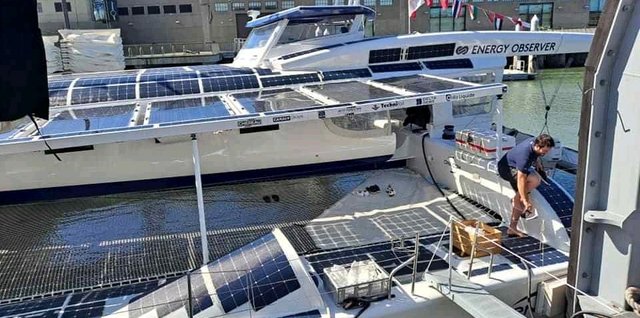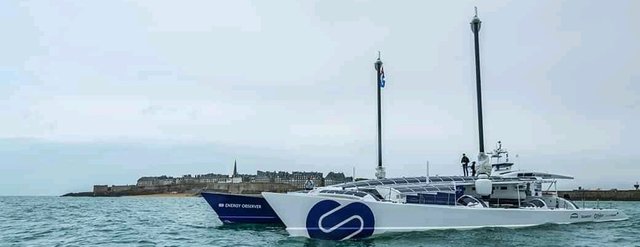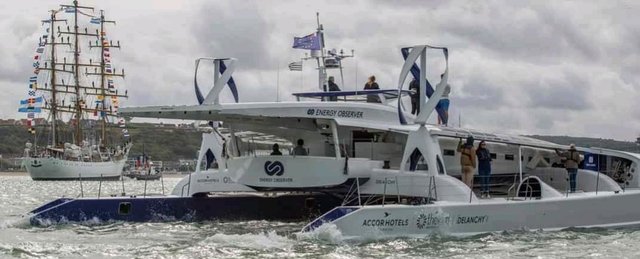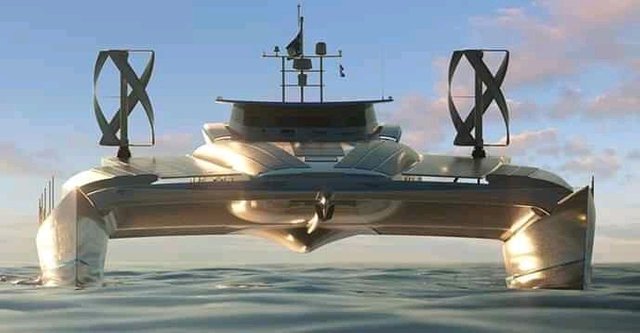The French-built Energy Observer,




the first vessel to be self-sufficient in energy, has taken on the challenge of sailing with no greenhouse gas or fine particle emissions and only renewable energy. It set sail from the port of Saint-Malo (France) on June 26, 2017, on a round-the-world voyage that would last until 2022, with not a single drop of fossil fuel on board.
This real-world experiment will put solar and wind energy to the test, as well as the creation of hydrogen from seawater. Beyond this technical accomplishment, Victorien Erussard, a French merchant marine officer and one of the project's initiators, and his crew aim to meet the designers of breakthrough technology solutions to "demonstrate that there is a way to clean and sustainable energy."
If we are to address global warming and the demographic and environmental issues of the twenty-first century, Erussard and his team believe that action, not words, are required. These are the questions that need to be answered today about how we travel, feed ourselves, build our homes, work, and educate ourselves. “All throughout the world, innovative solutions are being developed. This voyage is an opportunity to develop a community that crosses borders by discovering answers and linking them to one another,” says Jérôme Delafosse, the expedition's leader and a professional diver and documentary filmmaker on nature and biodiversity.
The fastest yacht in the world
The adventure began in 2013, when French navigator Frédéric Dahirel rescued one of the fastest ships in offshore racing history. It passed the symbolic barrier of 500 miles in twenty-four hours in 1984. And, in 1994, it enabled Sir Peter Blake, a famous New Zealand yachtsman who had retired from racing to devote himself to environmental exploration, to achieve the round-the-world record.
Dahirel's ambition was to construct the first wind-powered watercraft in France. This was significant. Erussard, his sailing partner, joined him in 2015. The project was then given a new direction after a meeting with the French Alternative Energies and Atomic Energy Commission (CEA)(link is external) and the Laboratory for Innovation in New Energy Technologies and Nanomaterials (CEA-Liten)(link is external). The task was to investigate a new technology, the use of hydrogen as an energy source.
A floating research facility
The yacht took two years to complete. The mainsail and jib were replaced by two electric motors. On its sides, two wind turbines and solar panels were erected. A twenty-metre-wide power kite can be deployed in the center. Two hydrogen generators are located beneath the hull. They are outfitted with turbines that utilise the hydraulic force created by the yacht's motion to generate energy. This fuels the yacht's engine, on-board energy requirements, as well as steering and telecommunications systems. The laboratory produces sluggishness; the yacht travels at eight to ten knots rather than the thirty knots it achieved when racing.
Hydrogen: the future's energy
The second breakthrough is the creation of hydrogen with no CO2 emissions. Hydrogen is viewed as a potential future solution for carbon-free wind and solar energy storage. Because this gas does not occur naturally in its pure form, it must be manufactured. The Energy Observer researchers chose seawater as an environmentally beneficial approach. “Today, ninety-five percent of the hydrogen utilized in the world is produced using polluting fossil fuels such as natural gas. “We want to show that ‘carbon-free' hydrogen can be produced,” adds Nicolas Degorce, a naval engineer who worked on the yacht's design.
For two years, some thirty CEA-Liten researchers tried to develop a hydrogen chain that could withstand the harsh circumstances faced at sea. Engineers, transportation specialists, naval architects, and new technology, as well as private enterprise, supported them. “Approximately twenty prototypes have been created. This is a fantastic opportunity to get them out of the lab and put them to the test,” Degorce says.
700 electronic sensors in the holds and on the bridge record the behavior of the many pieces of the energy jigsaw puzzle in real time: wind, solar, hydro-electric, and hydrogen. The data is then used by the researchers to strive to improve performance. This system of combining renewable energy, designed as a smart grid, could one day be employed in homes, factories, and cargo ships. It may also help to prevent the energy exclusion of the world's 1.2 billion people who do not have access to electricity.